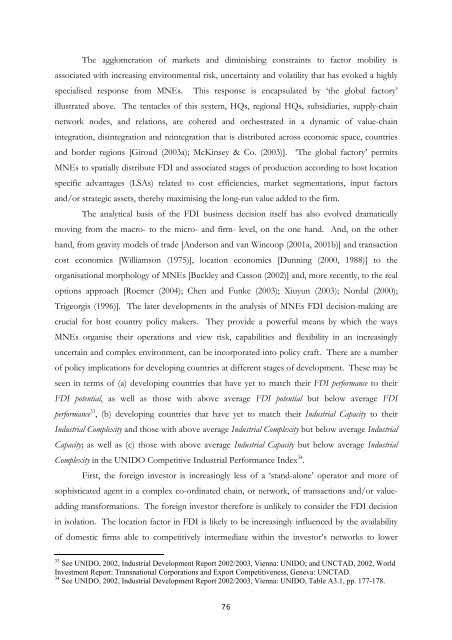(EGM) Foreign Direct Investment in Southeast Asia - Unido
(EGM) Foreign Direct Investment in Southeast Asia - Unido
(EGM) Foreign Direct Investment in Southeast Asia - Unido
You also want an ePaper? Increase the reach of your titles
YUMPU automatically turns print PDFs into web optimized ePapers that Google loves.
The agglomeration of markets and dim<strong>in</strong>ish<strong>in</strong>g constra<strong>in</strong>ts to factor mobility is<br />
associated with <strong>in</strong>creas<strong>in</strong>g environmental risk, uncerta<strong>in</strong>ty and volatility that has evoked a highly<br />
specialised response from MNEs. This response is encapsulated by ‘the global factory’<br />
illustrated above. The tentacles of this system, HQs, regional HQs, subsidiaries, supply-cha<strong>in</strong><br />
network nodes, and relations, are cohered and orchestrated <strong>in</strong> a dynamic of value-cha<strong>in</strong><br />
<strong>in</strong>tegration, dis<strong>in</strong>tegration and re<strong>in</strong>tegration that is distributed across economic space, countries<br />
and border regions [Giroud (2003a); McK<strong>in</strong>sey & Co. (2003)]. ‘The global factory’ permits<br />
MNEs to spatially distribute FDI and associated stages of production accord<strong>in</strong>g to host location<br />
specific advantages (LSAs) related to cost efficiencies, market segmentations, <strong>in</strong>put factors<br />
and/or strategic assets, thereby maximis<strong>in</strong>g the long-run value added to the firm.<br />
The analytical basis of the FDI bus<strong>in</strong>ess decision itself has also evolved dramatically<br />
mov<strong>in</strong>g from the macro- to the micro- and firm- level, on the one hand. And, on the other<br />
hand, from gravity models of trade [Anderson and van W<strong>in</strong>coop (2001a, 2001b)] and transaction<br />
cost economics [Williamson (1975)], location economics [Dunn<strong>in</strong>g (2000, 1988)] to the<br />
organisational morphology of MNEs [Buckley and Casson (2002)] and, more recently, to the real<br />
options approach [Roemer (2004); Chen and Funke (2003); Xiuyun (2003); Nordal (2000);<br />
Trigeorgis (1996)]. The later developments <strong>in</strong> the analysis of MNEs FDI decision-mak<strong>in</strong>g are<br />
crucial for host country policy makers. They provide a powerful means by which the ways<br />
MNEs organise their operations and view risk, capabilities and flexibility <strong>in</strong> an <strong>in</strong>creas<strong>in</strong>gly<br />
uncerta<strong>in</strong> and complex environment, can be <strong>in</strong>corporated <strong>in</strong>to policy craft. There are a number<br />
of policy implications for develop<strong>in</strong>g countries at different stages of development. These may be<br />
seen <strong>in</strong> terms of (a) develop<strong>in</strong>g countries that have yet to match their FDI performance to their<br />
FDI potential, as well as those with above average FDI potential but below average FDI<br />
performance 33 , (b) develop<strong>in</strong>g countries that have yet to match their Industrial Capacity to their<br />
Industrial Complexity and those with above average Industrial Complexity but below average Industrial<br />
Capacity; as well as (c) those with above average Industrial Capacity but below average Industrial<br />
Complexity <strong>in</strong> the UNIDO Competitive Industrial Performance Index 34 .<br />
First, the foreign <strong>in</strong>vestor is <strong>in</strong>creas<strong>in</strong>gly less of a ‘stand-alone’ operator and more of<br />
sophisticated agent <strong>in</strong> a complex co-ord<strong>in</strong>ated cha<strong>in</strong>, or network, of transactions and/or value-<br />
add<strong>in</strong>g transformations. The foreign <strong>in</strong>vestor therefore is unlikely to consider the FDI decision<br />
<strong>in</strong> isolation. The location factor <strong>in</strong> FDI is likely to be <strong>in</strong>creas<strong>in</strong>gly <strong>in</strong>fluenced by the availability<br />
of domestic firms able to competitively <strong>in</strong>termediate with<strong>in</strong> the <strong>in</strong>vestor’s networks to lower<br />
33 See UNIDO, 2002, Industrial Development Report 2002/2003, Vienna: UNIDO; and UNCTAD, 2002, World<br />
<strong>Investment</strong> Report: Transnational Corporations and Export Competitiveness, Geneva: UNCTAD.<br />
34 See UNIDO, 2002, Industrial Development Report 2002/2003, Vienna: UNIDO, Table A3.1, pp. 177-178.<br />
76

















